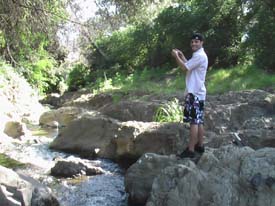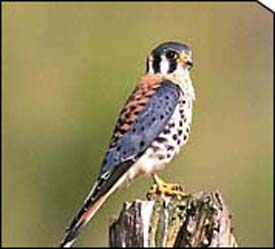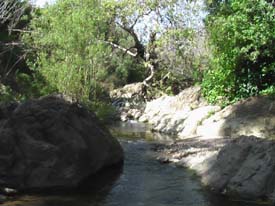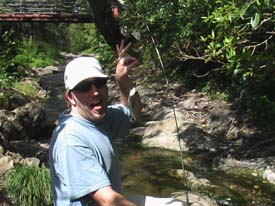|
Life history
During late winter or early spring the water temperatures begin to rise. The maturing adult rainbows usually seek out the
shallow gravel riffles or a suitable clearwater stream. Depemding on the location and water temperature the trout spawn from late March through early July. The female
uses her tail to prepare a nest, which is also called a redd, 4 to 12 inches deep
and 10 to 15 inches wide. The male fertilizes the 200 to 8,000 eggs that are deposited
in the redd by the female. Afterward they are covered up with gravel until hatched.
Hatching normally takes place between 3 weeks and as much as four
months after spawning. This also depends on the temperature of the water. It can take a few more weeks for the tiny fry to emerge from
the gravel. As they emerge the small trout assemble in groups
and seek shelter along the protected stream banks. They will feed on crustaceans, plant material, aquatic insects and
their own larvae. For the first few years the rainbow trout will live like this until they become more mature and move into larger areas of water. They will start to eat more like an adult fish which contains, salmon carcasses, eggs,
and even small mammals. The age of sexual maturity varies between individuals
due to population density, productivity
of the enviornment, and genetic makeup. In the wild, male
and female as young as 3 and 5 have
been found, but a majority of both sexes mature at age 6 to 7.
Spawning can range from annually to once each three years.
Rainbow trout up to age 11 have been observed spawning. Among rainbow, those living in or migrating to large
lakes, generally grow faster and larger
than fish which remain in streams year round.
:: A Fisherman's Dream ::
Calming stream
Windy breeze
Sunlight beam
Silence please
The thrill of the catch
The struggle of the fight
Your quite a match
I hope for a bite
The perfect season is spring
To see what fish the river will bring

This is Randy fishing at a local stream.
Links:

::
Birds ::

::
Wildlife ::
|




